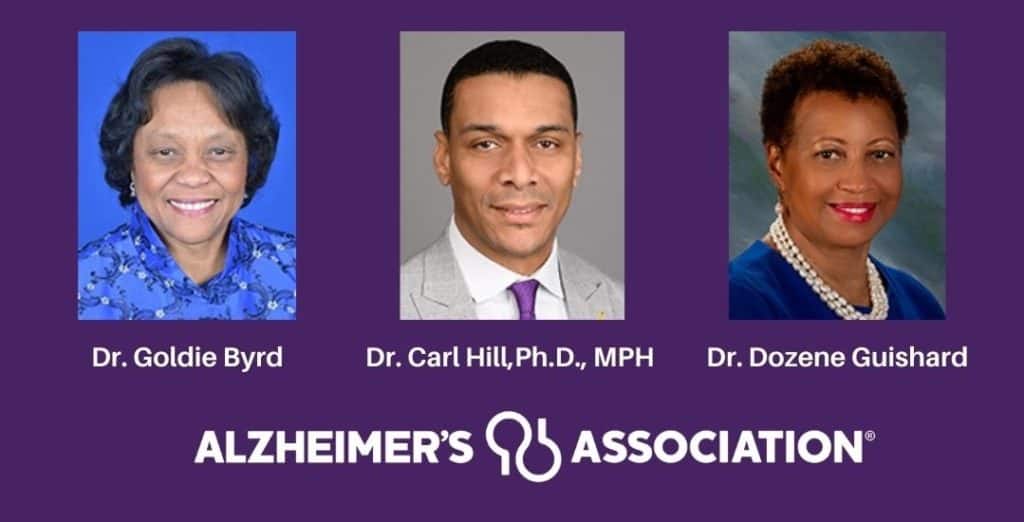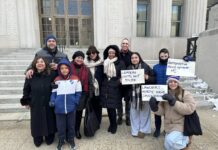
By Dan Murphy
According to the Alzheimer’s Association’s 2022 Facts & Figures Report, Black Americans are twice as likely to develop Alzheimer’s or another dementia as their white counterparts, but less likely to receive a diagnosis. On June 15, the Alzheimer’s Association hosted a virtual program to discuss this topic with three experts in the field.
Speakers participating in the forum, titled “Twice the Risk: Dementia’s Impact on Communities of Color” included Dr. Goldie Byrd, professor of public health sciences and Director of the Maya Angelou Center for Health Equity at Wake Forest School of Medicine; Dr. Carl V. Hill, Ph.D., MPH, Chief Diversity, Equity and Inclusion officer for the Alzheimer’s Association; and Dr. Dozene Guishard, Director of Health and Wellness Initiatives at the Carter Burden Network.
The panelists reviewed risk factors, the importance of getting diagnosed, research and other facts about dementia and people of color. Dr. Carl Hill explained that Diversity, Equity and Inclusion, DEI, “is an important part of our organization. People of color are more disproportionally affected and affected by what we do.”
Dr. Hill explained that vascular dementia affects the flow of blood to the brain, and that some populations are more likely to experience, diabetes, heart conditions, hypertension, obesity, smoking and depression, all of which are factors in a future diagnosis for dementia and Alzheimer’s.
“Six million Americans live with Alzheimer’s and one in three will die with Alzheimer’s or another dementia. African Americans are twice more likely to have dementia, and the Hispanic-Latino community is one and a half times more likely.
“35 percent of global dementia may be preventable. There is a genetic risk we must consider,” said Dr. Hill, who hoped that everyone who participated in the program “will walk away with an idea of how to get involved and walk away today and be involved.”
Dr. Dozene Guishard spoke about the need to improve the clinical workforce so that people of color will be treated by people of color. “There is a structural racism that has created a health inequity. The importance of being involved in clinical trials needs to be addressed.”
Dr. Guishard also highlighted the need to “accelerate research with persons of color” to determine the genetic causes, if any, for the increased likelihood of dementia in people of color.
Dr. Guishard introduced Reverend Erwin Lee Trollinger, from Calvary Baptist Church of White Plains. Rev. Trollinger spoke about his personal experiences as one of the 11 million informal caregivers in the United States who have cared for a loved one with dementia.
“I was a caregiver for my mother until she went home in 2021, at the age of 92. She showed signs of dementia, and I took her to the doctor, and we got the diagnosis and a plan for her to live with me for the last eight years of her life. Her speech and writing became less and less. One morning, I woke up and couldn’t find her. She was in my truck, and because of my Alzheimer’s training, I said to her, “OK, mom, we are back from the store, let’s go inside.”
“When she became bedridden, I learned how to care for her with the information I was provided by the Alzheimer’s Association,” he added.
Dr. Guishard explained how Rev. Trollinger is an example of how the Alzheimer’s Association is reaching out to churches and faith-based communities to raise awareness about services available.
Dr. Goldie Byrd spoke about the fact that “people of color have been disadvantaged and getting Alzheimer’s and dementia more often. With limited heath care, resulting in a later diagnosis, results in poorer treatment outcomes,” said Dr. Byrd, who provided factual data and charts which showed some of the ‘hot-spots’ for dementia in the United States where there are limited medical facilities and treatment options for dementia.
Dr. Byrd also spoke of the historical reasons why “people of color don’t want to get care or seek it out. The Tuskegee study is one reason why some people believe that medical research is biased against people of color, and why people don’t want to participate, or they believe that medical research is biased against people of color.”
In that study, referred to as the Tuskegee Syphilis Study, conducted between 1932 and 1972 by the United States Centers for Disease Control, (CDC), 400 African Americans with syphilis, to observe the effects of the disease when untreated. More than 100 died.
“Half of black America has experienced medical discrimination and been treated differently, based on color,” said Dr. Byrd, who explained how structural racism in medical treatment affects a delayed or a misdiagnosis of Alzheimer’s in people of color.
All of the panelists explained that while historical, social and cultural factors play a role in “Twice the Risk,” more research is needed to specify the genetic reasons for dementia, and Alzheimer’s, in people of color.
Other statistics provided at the forum included:
- Black caregivers are providing more hours on average to care for their loved ones than white caregivers but are less likely see use services and help available to them.
- Data from one study indicates 19 percent of Black and 14 percent of Hispanic adults age 65 and older have Alzheimer’s or dementia, compared with 10 percent of white older adults.
Everyone who attend the forum have a better understanding of the concern of dementia and Alzheimer’s for people of color, and the need to share with everyone the resources available. Visit Alz.org/hudsonvalley, for more information about local resources available.





